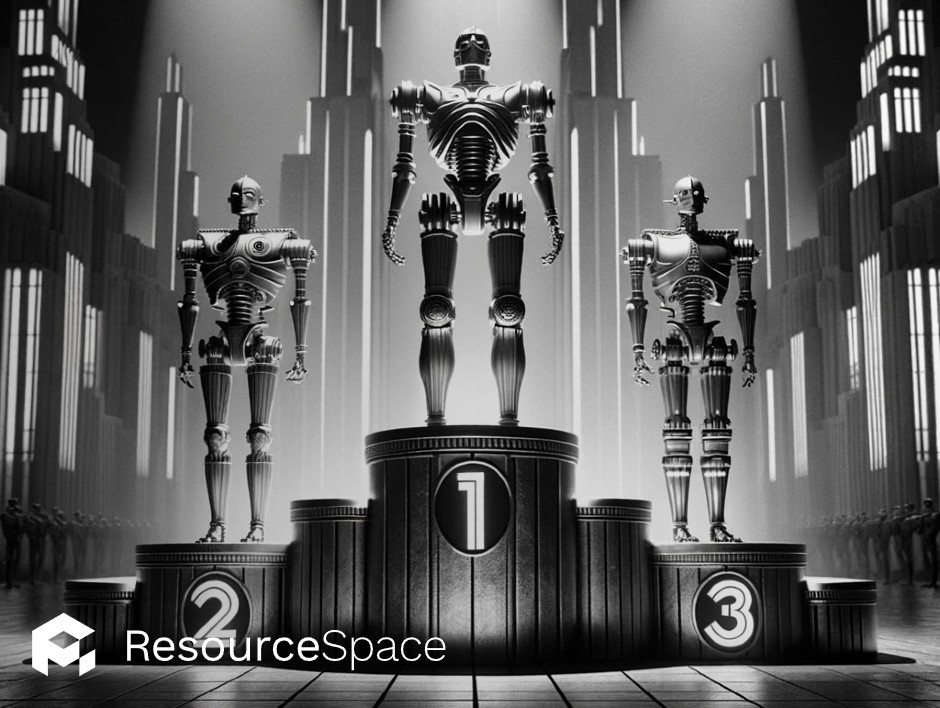
The team at ResourceSpace have been a joy to work with, helping us manage what could've been a really difficult transition every step of the way.
Blog
4th April 2024

Artificial intelligence has been making waves in the content marketing space over the last 12 months, with ChatGPT, Google’s Bard offering and many other platforms that leverage AI technology promising to revolutionise written content creation.
However, some of the most interesting innovation has been around visual content. While the early examples of AI-generated images were somewhat bizarre, the rapid pace of improvement means organisations have to start taking it seriously.
For small teams with limited graphic design resources, AI image generation tools can be incredibly useful, particularly for illustrative images, such as blog feature images.
But how do these platforms compare?
Pros |
Cons |
Price: Free with ChatGPT Plus; $20/month standalone
Within this emerging sector, DALL-E 3 is one of the best known names, and one you might already be familiar with.
DALL-E 2 was probably the first AI image generator to create content that was actually good enough to use in digital content. The second iteration of this software is still available, but its successor represents a big improvement, producing more interesting but also, crucially, more realistic and consistent results.
DALL-E3 is included as part of a ChatGPT subscription, making it the obvious choice if you’re already making use of OpenAI’s copy generating platform, although the $20/month fee is on the high side if you don’t actually want ChatGPT. Fortunately, it’s also freely available via Microsoft Copilot.
Another key benefit of DALL-E 3 is that it’s incredibly easy to use. Simply enter a prompt describing what you’d like created, and two to four graphics will be generated within moments.When creating images with ChatGPT, you can ask the AI to make changes or additions to the images so you can refine it to exactly what you want.
OpenAI also offers an API which allows DALL-E 3 (and its predecessor) to integrate with other applications.
Pros |
Cons |
Price: $1.18/100 credits
We’re big fans of open source software here at ResourceSpace, and Stable Diffusion is the only AI image generating software on this list that fits the bill. This means two things:
However, they’ve also created a public app called DreamStudio that offers a lot of customisation and control over what you create. For example, alongside entering your prompt there are sliders to specify how large the image should be, how closely the AI should stick to your original prompt, and how many images it generates. It’s a powerful and fast platform, but it can struggle with more complex requirements.
DreamStudio is one of the few major AI generators that are still offering free credits, although the downside of the credits model is that it can become expensive if you’re a power user.
Pros |
Cons |
Price: $10/month
The creative output of Midjourney is some of the best around, with realistic, detailed and artistic images enhanced with the extensive customisation options available, but there’s one big downside—the beta can only be accessed via Discord.
Although the Discord community is active, it’s still an odd way of creating images, while the mechanics of the platform means that every image generated is publicly visible. Not such an issue, for casual use, but if you want to use it for your business that might be a problem.
Fortunately, a web app version is expected soon, but in the meantime Midjourney is awkward to set up and has quite a steep learning curve. Pricing wise, this is a cheaper alternative to DALL-E 3 (if you exclude the value of having access to ChatGPT Plus) at $10/month, but free trials are currently suspended due to high demand.
Midjourney might prove to be the best AI image generator around once it’s released from the shackles of Discord, but for now it has to settle for the bronze medal.
Pros |
Cons |
Price: Free plan available; Premium from $4.99/month
Adobe isn’t new to leveraging AI in their software products, but Firefly is their first dedicated AI image tool.
Firefly boasts a text-to-image prompt tool, but its true power lies in how it integrates with the broader Adobe Creative Suite, and it’s at its best when used within Photoshop. In addition to creating images from detailed text descriptions (although this is, admittedly, hit and miss) it can create text effects, recolour vector artwork and add elements to an existing image. The latter is possible thanks to ‘Generative Fill’, a Photoshop feature that can replace an element of an image with something else, simply by clicking a button and typing a prompt.
When it comes to what it does well, Adobe Firefly is arguably the most powerful tool on this list, but it’s limitations when it comes to text-to-image generation, and the fact it requires an Adobe Creative Cloud subscription to get the best out of it, costs it a top three spot.
Pros |
Cons |
Price: Free
Image Creator from Microsoft Designer is a fast and powerful AI image tool, mainly because it’s powered by OpenAI’s DALL-E 3. This means it’s able to produce high quality images but, unlike many of the other tools on this list, is free to access—as long as you have a Microsoft account.
Image Creator is also accessible via Copilot. Although not as proficient as DALL-E 3 and ChatGPT, it’s still great to have the two functions in one place.
Pros |
Cons |
Price: Free
Google’s foray into AI image generation came surprisingly late—a whole year after DALL-E 2 was launched.
However, ImageFX is an easy-to-use, powerful tool that is still free, even if it requires a Google account to access. You can also refine the results with ‘expressive chips’, with drop-down menus to make simple adjustments, although you can’t make more freestyle alterations post-generation.
You can also choose the style you’d like your image to be rendered in, including photorealistic, 35mm film, minimalist, sketch and more.
Pros |
Cons |
Price: $14.99/100 prompts
The debate about whether or not AI image generators will replace graphic designers and photographers will rage on for a while longer, but stock images might be one of the first dominoes to fall.
AI can already do a pretty good job of creating stock-style imagery, but Generative AI by Getty excels at this particular genre.
Generative AI can be accessed via iStock, and has been trained on Getty’s extensive stock image library, which is the secret to the platform’s specialism, but it isn’t so good at more creative requirements.
Another of the key benefits is that Getty guarantees their AI images are ‘commercially safe’, which is valuable in the murky world of AI image copyright.
Pros |
Cons |
Price: Free with ads; Premium from $5/month
The second open source AI image tool in this list, Craiyon is ideal for beginners, with no previous experience of similar tools required to get going. The platform is also free (with ads) and offers unlimited access but, and it’s a big but, the images lack the realism and detail of the other tools listed here. Check out the below result for the prompt, ‘Ginger cat sleeping on a windowsill’:

Craiyon also takes much longer to generate results than alternatives and, ultimately, doesn’t create content that’s suitable for business use.
#AI
#ContentMarketing
#ChatGPT
#OpenAI
#Google
#GenerativeAI
#Getty